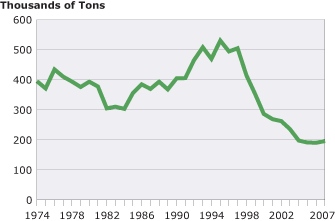Nitrogen Oxides
Nitrogen oxides (NOx) are pollutant gases produced by burning fossil fuels, motor-vehicle exhaust, decaying vegetation, and many industries. Although high levels of NOx are detrimental to human health, the main concern is their role in the production of ozone and acid rain.
Ozone is formed by a series of complex reactions involving other chemical substances, primarily NOx and volatile organic compounds. The most effective strategies for ozone reduction focus on the control of NOx emissions, since most volatile organic compounds in the region come from natural sources.
A large proportion of the Tennessee Valley’s NOx emissions are generated by human activity: fossil power plants and automobiles produce about a third of the total NOx emissions each. They’re also the second-largest human-generated source of excess acidity in rain, after sulfur dioxide.
NOx emissions at TVA power plants
Click chart for raw data
What TVA is doing about NOx emissions
At present, 58 of TVA’s 59 coal-fired units have combustion controls to reduce NOx. The 59th is an atmospheric fluidized bed combustion plant, which, by design, already operates with low NOx emissions.
TVA also operated selective catalytic reduction (SCR) systems on 18 of its largest coal-fired units, 57 percent of the coal-fired capacity, during the 2004 ozone (May - September) season.
TVA staff continue to look for better, more cost-effective ways to reduce emissions while continuing to supply reliable, affordable electricity and manage debt reduction in the light of evolving emission reduction requirements. Those efforts have led TVA to make some changes in its NOx reduction projects.
TVA plans to transition from a NOx emission reduction strategy that depends primarily on the installation of SCR systems and NOx Star technology to a strategy that continues to depend on SCRs, but also on a more proven technology, selective noncatalytic reduction (SNCR) systems.
TVA will evaluate the use of the SNCR technology by carrying out demonstrations on two of its generating units: Johnsonville Unit 1 in Tennessee, and Shawnee Unit 1 in Kentucky. These are representative of the different types of TVA units where the technology could be employed if the demonstration is successful.
SNCR is a simpler technology than SCR, although both work to change nitrogen oxides to harmless nitrogen and water vapor. SNCR provides a lower level of NOx reduction than SCR, but is much less costly. In its demonstration project, TVA will be evaluating the amount of NOx reduction that can be achieved for comparison with the cost and removal efficiencies of other technologies.
TVA recently signed a $2.4 million contract with Fuel-Tech for the two demonstration projects.
